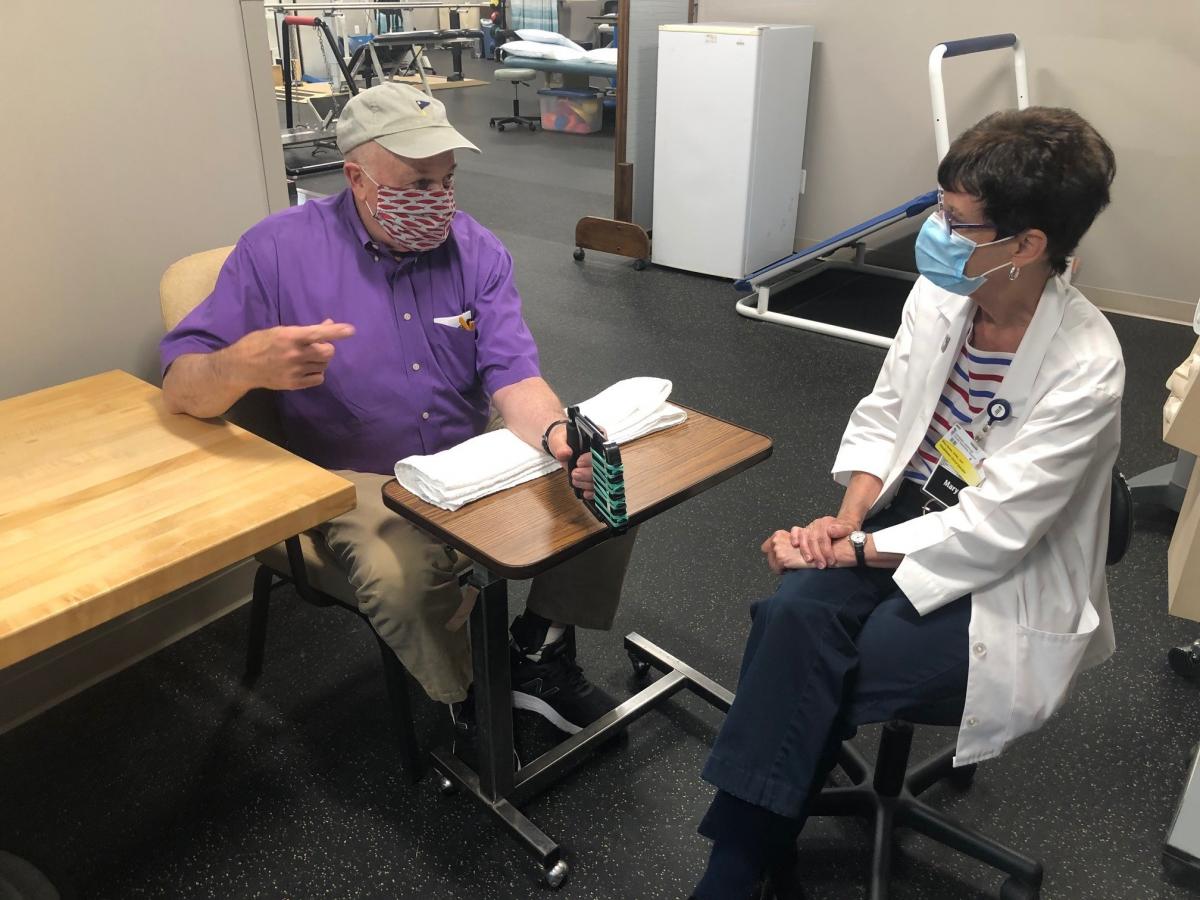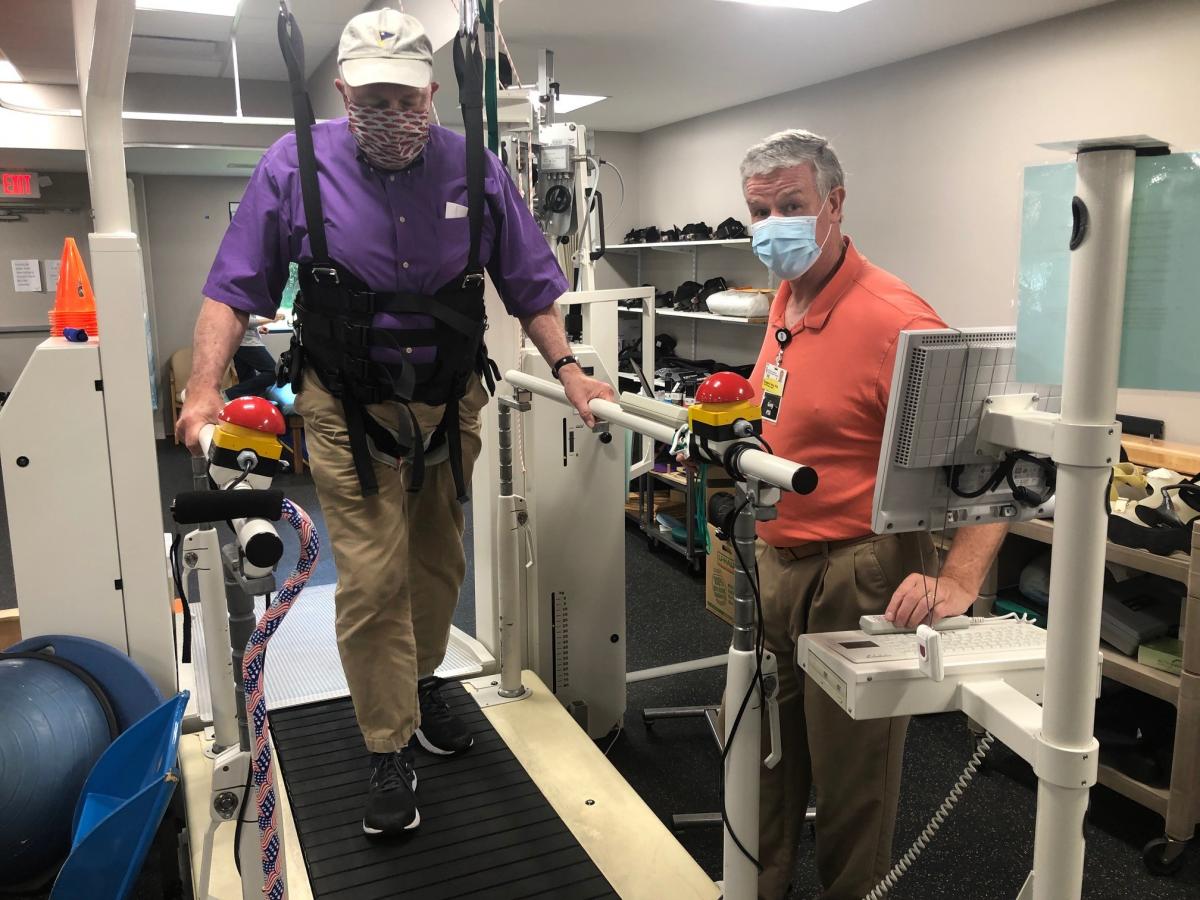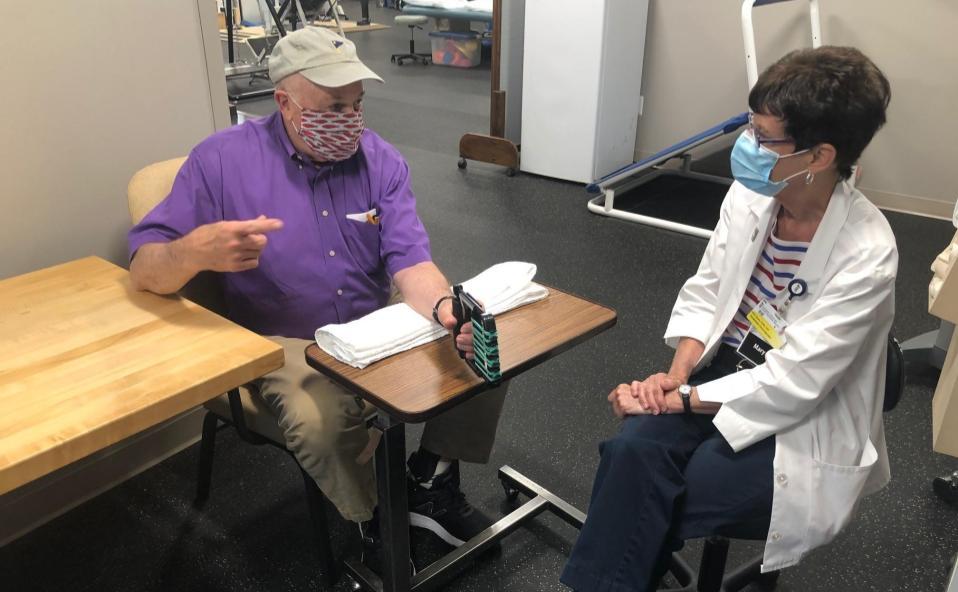
Tom Mendenhall works onon his grip with Shore Rehab at Easton’s certified hand therapist Mary Hynes.
At 72 years young, Tom Mendenhall of St. Michaels was enjoying the fifth year of his retirement from a career in business and administration. In his last full-time position, he’d spent seven years on the leadership team of Wye River Upper School in Queen Anne’s County, through which he came to understand the challenges experienced by teens with learning differences. Post retirement, he started a new venture advocating for children with special education needs and their parents.
A poker game with friends at the Chesapeake Bay Yacht Club was part of Mendenhall’s weekly routine. In early April 2021, he was enjoying the game until he tried to stand and discovered that he couldn’t put any weight on his left leg. Fortunately, one of the group knew the symptoms of a stroke and directed Mendenhall to smile and then to raise his arms. His smile was lopsided and his right arm was not as high as his left. “We think you’re having a stroke,” his friend said. “Say a complete sentence.” In typical fashion, Mendenhall replied, “I’m not having a stroke!”
Nonetheless, his friends called for an ambulance, which arrived quickly and transported him to UM Shore Medical Center at Easton, which is designated as a Primary Stroke Center. There he received the clot-busting drug tPA, also known as Alteplase or Activase, which restored blood flow to areas of his brain that were affected by the stroke.

As physical therapy assistant Greg Terry stands by, Tom Mendenhall walks on the Lokomat, which helps improve his gait. Shore Rehab at Easton is now located in The Orthopedic Center.
Fortunately, the stroke had not impacted Mendenhall’s speech or cognitive ability, but walking – even standing – was impossible. During his admission for acute care he was evaluated by physical and occupational therapists who recommended him for acute rehab, and was admitted to the Requard Center for Acute Rehabilitation on the 5th floor of the Easton hospital. “Mr. Mendenhall’s proprioception, which means perception or awareness of the position and movement of the body, was very poor,” said physical therapy assistant Ren Boettger, who has served on the Requard care team since 2014. “This, along with weakness in his left leg, was causing him to lean and pull so much that it took three of us to help him walk even a few steps.”
Initially, Boettger had doubts about how quickly Mendenhall could progress. “He described how active he had been so I was really worried for him,” she said. “He was looking forward to a family vacation at the beach in July, and I was thinking, no, he’s not going to be ready to really enjoy that.”
Within a few days, however, Mendenhall was making rapid improvement. “He worked really hard, so much so that I sometimes had to reel him in a little,” Boettger said. “But about two weeks later, he was using a walker safely and ready for discharge. That’s the crazy thing about stroke recovery in the acute rehab setting – no two patients are alike and it’s hard to predict how long it will take. But we are always happy to be surprised by patients who progress more rapidly than we might have guessed.”

Shown in front of the Rehab Services entrance of The Orthopedic Center in Easton, Tom Mendenhall is making good progress in his recovery from a stroke last spring.
“The Stroke Center team and the therapists on Requard were excellent, everyone was so encouraging,” said Mendenhall. Ready to begin outpatient rehab, he was further motivated by the knowledge that for most patients recovering from stroke, the greatest progress is made within the first three months of the event.
On May 1, Mendenhall began outpatient rehab twice weekly at Shore Rehab at Easton, located in the newly expanded and renovated Orthopedic Center. His therapy team included physical therapist Carla Smith and physical therapy assistant Greg Terry, who focused on his endurance, balance and gait, along with occupational therapist/certified hand therapist Mary Hynes, who guided him through therapy to improve his left-hand grip and manual dexterity.
An important tool in Mendenhall’s gait improvement has been the Lokomat, a rehab technology that is usually found only in large research hospitals. A computer controls the pace of the Lokomat while recording the amount of weight Mendenhall places on the treadmill, his walking distance and speed, as well as his body’s response to movement. Using the data, Smith and Terry determine the balance between the assistance provided by the robotic legs and Mendenhall’s; as his gait improves, the technology adapts to provide minimal assistance and record his progress over time.
By early July, Mendenhall was able to walk up to 60 feet with the assistance of a cane, and when outdoors, with a brace on his leg to prevent foot drop. “The hardest part is walking on grass,” he said. “You have to really push yourself.”
He also was making progress with his grip and dexterity, thanks to the guidance of Hynes, who is the only certified hand therapist in the five-county region served by UM Shore Regional Health. “Fine motor skills seemed more challenging,” he said. “I could tell I was making progress — for example, I went from picking up pennies to picking up dimes — but I was surprised by how hard it was to do simple things, for example, clipping my own nails. And with all my therapy, I do better early in the day since I’m less tired.”
According to Hynes, Mendenhall’s early progress was promising. “In the first few months, his gross and fine motor coordination, endurance to activity and function, and strength had improved,” she said.“By early July he was able to perform self-care skills like buttoning, opening containers, jars and bottles, and shuffling cards. And he is always striving to do better, as he continues to work on endurance, strength, function, gross and fine motor coordination.”
Doing better has meant work at home as well as in rehab sessions. At his therapists’ recommendation, Mendenhall does hand and arm exercises at home and practices walking in his neighborhood. He no longer needs the leg brace, and he was able to navigate the sand dunes and the beach in South Carolina by using hiking poles.
As he continues his therapy and his advocacy work for students with learning differences, Mendenhall acknowledges the mental challenges of stroke rehab as well as the physical ones. “For success in rehab, you have to get over what you can’t do and focus on what you can,” he said. “I’m a type A personality and I want to get everything done NOW, but I’ve worked hard to be more patient.”
“National Rehabilitation Week, September 19-25, is the perfect time to highlight the excellent work our inpatient and outpatient rehab teams do for our patients,” said Erin Scheele, Director of Comprehensive Rehabilitation Services, UM Shore Regional Health. “Mr. Mendenhall’s story is a great example of our therapists work with patients to help restore their functionality, mobility and independence, and get them back to living their best lives.”
About University of Maryland Shore Regional Health
As part of the University of Maryland Medical System (UMMS), University of Maryland Shore Regional Health is the principal provider of comprehensive health care services for more than 170,000 residents of Caroline, Dorchester, Kent, Queen Anne’s and Talbot counties on Maryland’s Eastern Shore. UM Shore Regional Health’s team of more than 2,200 employees, medical staff, board members and volunteers works with various community partners to fulfill the organization’s mission of Creating Healthier Communities Together.
About the University of Maryland Medical System
The University of Maryland Medical System (UMMS) is a university-based regional health care system focused on serving the health care needs of Maryland, bringing innovation, discovery and research to the care we provide and educating the state’s future physician and health care professionals through our partnership with the University of Maryland School of Medicine and University of Maryland, Baltimore professional schools (Nursing, Pharmacy, Social Work and Dentistry) in Baltimore. As one of the largest private employers in the State, the health system’s more than 29,500 employees and 4,000 affiliated physicians provide primary and specialty care in more than 150 locations, including 13 hospitals and 9 University of Maryland Urgent Care centers. The UMMS flagship academic campus, the University of Maryland Medical Center in downtown Baltimore, is recognized regionally and nationally for excellence and innovation in specialized care. Our acute care and specialty rehabilitation hospitals serve urban, suburban and rural communities and are located in 13 counties across the State. For more information, visit www.umms.org.



Write a Letter to the Editor on this Article
We encourage readers to offer their point of view on this article by submitting the following form. Editing is sometimes necessary and is done at the discretion of the editorial staff.